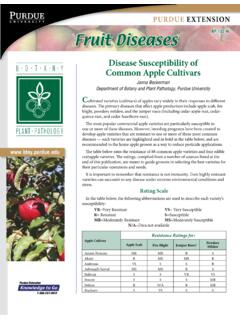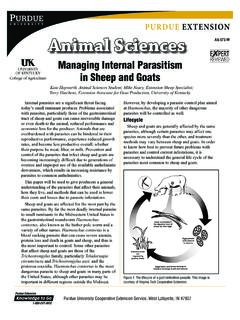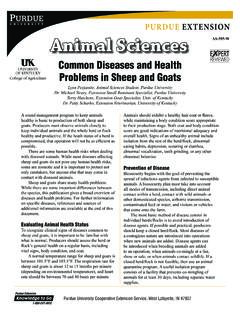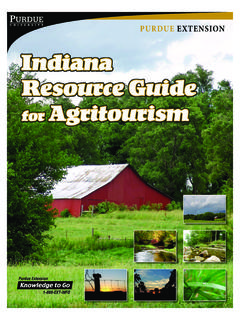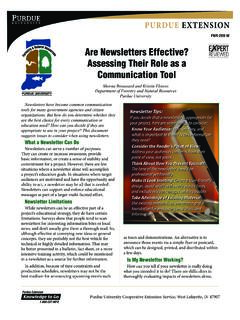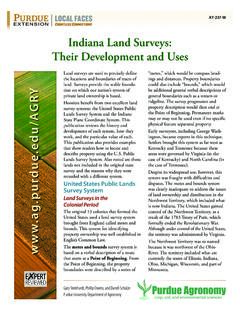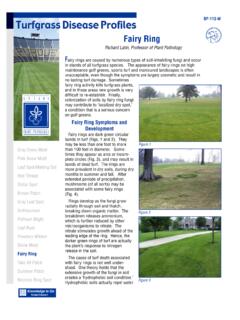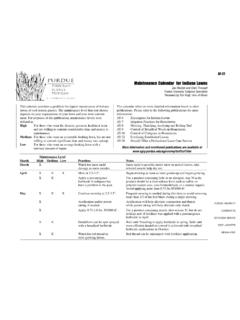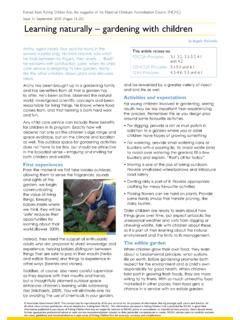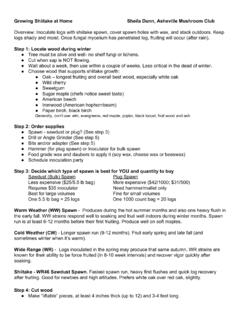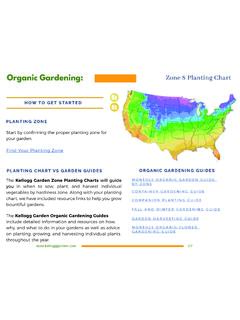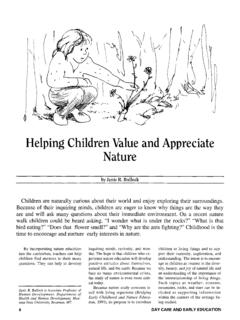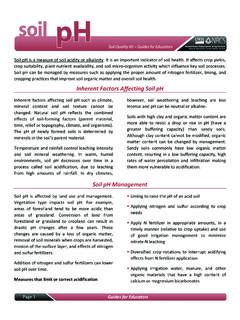Transcription of BP-69-W Disease Management Strategies - Purdue University
1 1 Purdue organic FungicidesJanna BeckermanDepartment of Botany and Plant Pathology, Purdue UniversityBP-69-WDisease Management Strategies Photo by Dan EgelFigure 1. Some plants can be allergic to a given chemical this is called phytotoxicity. Always check product labels to reduce the chance of unintentionally injuring confronted with a Disease , many homeowners and landscape professionals say they prefer to use organic products because they are more environmentally friendly. Others say they just want to use a product that works, regardless of the ecological impact. Many organic fungicide products can satisfy the needs of both groups in one container, providing effective control with minimal ecological impact. However, improperly using any chemical ( organic or otherwise) will result in poor control and may harm non-target publication offers Strategies for properly using organic fungicides and describes various kinds of these Health ManagementEffectively using organic fungicides (or any fungicide for that matter) requires a solid plant health Management strategy.
2 A traditional integrated pest Management (IPM) program focuses solely on the pest or pathogen. However, good plant health Management focuses more on the actual plant, including: Identifying the right plant for the site. Using resistant varieties (when available). Practicing Strategies that help keep that plant healthy and avoid insect and Disease prob-lems in the first key to effective plant health Management is prevention. This includes doing your homework before planting by carefully matching plants that are appropriate to the type of soil, sunlight levels, and watering conditions of the site. Once the plants are in the ground, successful plant health Management relies on proper sanitation, appropriate fertilization, and necessary pruning practices. Using pesticides may be one part of a plant health program, but it is never the sole strategy for plant health Certain Before You sprayBefore applying any pesticide, good plant health Management requires that the problem be properly diagnosed before any Management program is implemented.
3 Purdue Extension publications provide descriptions of some landscape plant Disease problems ( #3) and some fruit Disease problems ( #2). The most accurate diagnosis, however, will come from a certified testing lab, like the Purdue Plant for Horticultural Crops2 Purdue extensionDisease Management Strategies Using organic Fungicides BP-69-W & Pest Diagnostic Laboratory (for sampling and submission guidelines, visit ). After accurately diagnosing the problem, the next step is to identify which pesticide is best for the problem you wish to manage. Remember to always check the product label to be sure the plant you wish to treat is labeled and that no contraindications exist. The label is not only the law (which means you must follow the recommended doses and rates) it also provides im-portant warnings to help protect your plants and your health.
4 Sometimes, a plant is allergic to a given chemical (termed phytotoxicity). In such cases, the allergic plant is listed as a contraindicated plant on the product label (Figure 1). Pesticide labels also provide temperature and weather limitations, and requirements for protective measures you should take before follow the labeled rates for any pesticide. Too often, users apply pesticides at higher rates than specified on the label, hoping for better control or a more lasting effect. But over applying a pesticide like this is dangerous for the plant, the applicator, and the environment. The application rates on a pesticide label are based on the amounts needed for control. If these rates don t achieve reasonable control, it is often the result of choosing the wrong pesticide for the problem, making an incorrect diagnosis, or applying the chemical at the improp-er time not applying an inadequate , it is frequently necessary to repeat applications at intervals of 7, 10, or 14 days over the growing season to protect the new growth that has developed since the last spray, or to replace spray residues that are no longer effective because of weathering and chemical breakdown.
5 Due to their nature, or-ganic pesticides often require more frequent applications than their synthetic , following practices that prevent diseases is es-sential to successful organic gardening (or any type of plant health Management ) because established populations of plant pathogens don t respond well to any chemical organic or are a number of organic fungicides growers can use to prevent plant diseases: Sulfur Copper Oils BicarbonatesEach of these products and their uses are described in more detail is the oldest recorded fungicide and has been used for more than 2,000 years. Early in agricultural history, the Greeks recognized its efficacy against rust diseases on 1. Natural Fungicides AvailableThis is a partial list of organic fungicides available for home or professional use.
6 Note: not all natural fungicides are considered organic , or bear organic Materials Review Institute (OMRI) ingredientChemicals for HomeownersChemicals for ProfessionalssulfurBonide Liquid Sulfur Bonide Sulfur Plant Fungicide micronized sulfurMicrothiol Disperss , micronized sulfurSulfur 6L Sulfur 90W lime-sulfurPolysul Lime Sulfur Spray lime-sulfurlime sulfur solutionlime sulfur sixcopperLiqui-Cop Concern Copper Soap Liquid Copper 4E Copper Dust Kocide 3000 Cuprofix Ultra 40 Disperss COCS copperhorticultural oilGreen Light Horticultural Oil All Seasons Horticultural Oil Summit Year Round Horticultural Oil Dormant Oil 435 Forest Crop Oil JMS Stylet-Oil organic JMS Stylet-Oil ProNatural Dormant Oil neem oil70% neem oilTriact-70 bicarbonatesGreenCure Kaligreen Bi-Carb Remedy Armicarb 100 Remedy 3 Purdue extensionDisease Management Strategies Using organic Fungicides BP-69-W Although few homeowners grow their own wheat, sulfur can be a preventive fungicide against powdery mildew, rose black spot, rusts.
7 And other diseases. Sulfur prevents fungal spores from germinating, so it must be applied before the Disease develops for effective results. Sulfur can be purchased as a dust, wettable powder, or not use sulfur if you have applied an oil spray within the last month the combination is phytotoxic (plant-killing). Likewise, do not use sulfur when temperatures are expected to exceed 80 F to reduce the risk of plant damage. Finally, there are certain sulfur-shy plants (including varieties of gooseber-ries, currants, apricots, raspberries, and cucurbits) that should never be treated with is a form of sulfur mixed with lime (calcium hydroxide), and is mostly used as a dormant spray, meaning it should not be applied to plant foliage. Lime-sulfur is more ef-fective than elemental sulfur at lower concentrations; however, its strong, rotten-egg odor usually discourages its use over extensive copper fungicide formulations are available to organ-ic growers.
8 Regardless of the formulation, copper fungicides effectively kill fungi and bacteria. Unfortunately, care must be taken to prevent copper from damaging the host sulfate (also called bluestone) was one of the original forms of copper used as a mixture combines copper sulfate with lime (cal-cium hydroxide), which acts as a safener to neutralize the acidic copper sulfate this reduces plant damage. Although not the oldest fungicide, Bordeaux mixture has been used successfully for more than 150 years on fruits, veg-etables, and ornamentals. Sulfur is only fungicidal, but Bor-deaux mixture also is bactericidal, which means that it can be effective against Disease caused both by fungi (such as powdery mildew, downy mildew, and various anthracnose pathogens) and by bacteria (such as bacterial leaf spots and fire blight).
9 Bordeaux mixture owes part of its success to its ability to persist through spring rains and adhere to plants. Bordeaux mixture comes in several formulations. One of the most popular, effective, and least phytotoxic formulations for general home garden and orchard use is the 4-4-50 formulation. The numbers translate into the number of pounds of copper sulfate (4) and pounds of lime (4) that should be in 50 gallons of wa-ter. This formulation was developed because copper, like sulfur, can be foliage is especially sensitive to copper, so if you apply Bordeaux mixture in the spring after the plant breaks dormancy (for example, to prevent infection by the fire blight bacterium, Erwinia amylovera), use a weaker, more dilute formulation to reduce the risk of plant injury. Take care when applying this fungicide to the young, tender leaves of apple (Malus spp.)
10 , pear (Pyrus spp.), plum (Prunus spp.), or rose (Rosa spp., but especially R. rugosa spp. and hybrids). Sensitive plants include geranium (Pelargonium sp.), ivy (Hedera sp.), pansy (Viola x wittrockiana), celery (Apium graveolens), strawberry (Fragaria sp.), azalea and rhododendron (Rhododendron spp.), dogwood (Cornus sp.), juniper (Juniperus sp.), and alyssum (Alyssum spp.).For some diseases or late-season applications, some Bor-deaux mixture labels recommend twice as much fungicide, which translates into an 8-8-50 formulation. As always, refer to the label for recommended Bordeaux mixture when it s hot (above 85 F) may cause leaves to turn yellow and drop. Additionally, leaves can be burned if it rains soon after a Bordeaux application. The burn risk can be reduced by adding a spray oil (see below).
